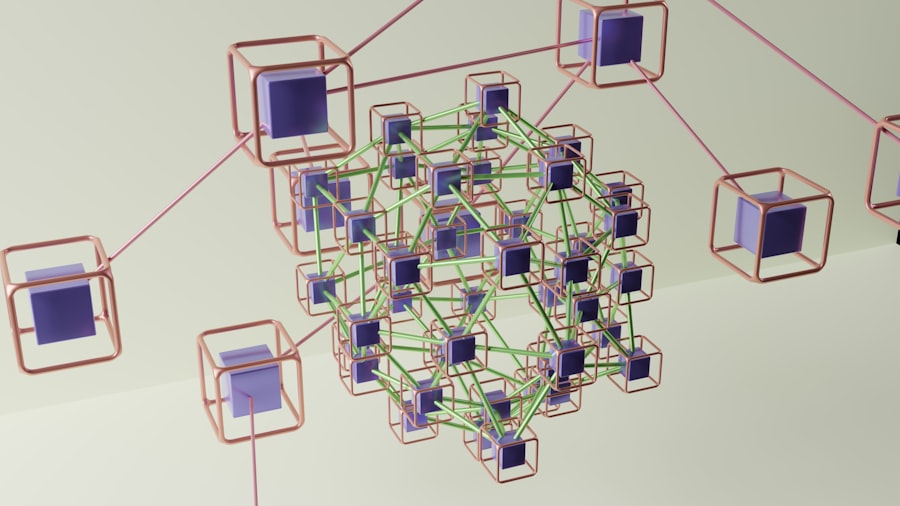The Default Mode Network (DMN) is a fascinating aspect of human brain function that has garnered significant attention in recent years. You may not realize it, but the DMN is active when your mind is at rest, wandering through thoughts and memories, rather than focusing on the external environment. This network comprises several interconnected brain regions, including the medial prefrontal cortex, posterior cingulate cortex, and the angular gyrus.
When you engage in daydreaming, self-referential thought, or even planning for the future, it is the DMN that is hard at work. Understanding this network is crucial because it plays a pivotal role in how you process information and navigate your internal world. As you delve deeper into the workings of the DMN, you might find it intriguing to learn that this network is not merely a passive observer of your thoughts.
Instead, it actively contributes to your sense of self and your ability to reflect on past experiences. When you reminisce about a cherished memory or contemplate your goals, the DMN is engaged in a complex interplay of neural activity. However, this network can also become overactive, leading to rumination and excessive self-referential thinking.
Recognizing the dual nature of the DMN is essential for understanding its impact on your mental well-being.
Key Takeaways
- The Default Mode Network (DMN) is a network of brain regions that is active when the mind is at rest and not focused on the outside world.
- The DMN can have a significant impact on mental health, contributing to conditions such as anxiety, depression, and ADHD.
- Techniques for quieting the DMN include meditation, mindfulness, and cognitive behavioral therapy, which can help reduce rumination and negative thought patterns.
- Mindfulness plays a crucial role in controlling the DMN, as it helps individuals become more aware of their thoughts and emotions, leading to better self-regulation.
- Meditation can be a powerful tool for controlling the DMN, as it can help individuals develop greater control over their thoughts and emotions, leading to improved mental well-being.
Recognizing the Impact of the DMN on Mental Health
The influence of the DMN on mental health cannot be overstated. When you find yourself caught in a cycle of negative thoughts or excessive worry, it is often the DMN that is driving this behavior. Research has shown that individuals with anxiety and depression frequently exhibit heightened activity in this network.
This overactivity can lead to a persistent focus on negative experiences and self-criticism, making it challenging to break free from these detrimental thought patterns. By recognizing how the DMN operates, you can begin to understand why certain mental health challenges arise and how they can be addressed. Moreover, the relationship between the DMN and mental health extends beyond just anxiety and depression.
Conditions such as post-traumatic stress disorder (PTSD) and obsessive-compulsive disorder (OCD) have also been linked to dysregulation within this network. When you experience trauma or engage in compulsive behaviors, the DMN may become hyperactive, reinforcing negative thought loops and emotional distress. Acknowledging this connection empowers you to take proactive steps toward managing your mental health by targeting the underlying mechanisms at play.
Techniques for Quieting the DMN

If you find yourself overwhelmed by the incessant chatter of your mind, there are several techniques you can employ to quiet the DMN. One effective method is to practice focused attention exercises. By directing your attention to a specific object or sensation—such as your breath or a sound in your environment—you can create a mental space that allows the DMN to settle down.
This practice not only helps reduce rumination but also enhances your ability to concentrate on the present moment. Another technique involves engaging in activities that require full immersion and concentration. Whether it’s painting, playing a musical instrument, or participating in a sport, these activities can effectively distract your mind from its habitual patterns of thought.
When you immerse yourself in a task that demands your full attention, you create an opportunity for the DMN to take a backseat, allowing for a more peaceful mental state. Experimenting with different techniques can help you discover what works best for you in quieting the DMN.
The Role of Mindfulness in Controlling the DMN
| Study | Participants | Duration | Findings |
|---|---|---|---|
| Study 1 | 30 | 8 weeks | Reduced DMN activity and improved attention |
| Study 2 | 45 | 12 weeks | Decreased DMN connectivity and reduced mind-wandering |
| Study 3 | 25 | 6 months | Enhanced emotional regulation and decreased DMN activation |
Mindfulness has emerged as a powerful tool for managing the Default Mode Network and its effects on your mental health. By cultivating mindfulness, you learn to observe your thoughts without judgment, creating a space between yourself and the incessant chatter of the DMN. This practice encourages you to acknowledge your thoughts as they arise while gently guiding your focus back to the present moment.
Over time, this can lead to a reduction in the overactivity of the DMN and an increased sense of calm. Incorporating mindfulness into your daily routine can take many forms. You might choose to engage in mindful breathing exercises, where you focus solely on your breath as it flows in and out of your body.
Alternatively, you could practice mindful walking, paying close attention to each step and sensation as you move through space. These practices not only help quiet the DMN but also enhance your overall awareness and appreciation of life as it unfolds.
Harnessing the Power of Meditation for DMN Control
Meditation is another effective strategy for gaining control over the Default Mode Network. When you meditate, you create an intentional space for stillness and reflection, allowing you to disengage from the habitual thought patterns driven by the DMN. Various forms of meditation—such as loving-kindness meditation or body scan meditation—can help you cultivate a sense of inner peace while simultaneously reducing activity in this network.
As you develop a regular meditation practice, you may notice profound changes in how you relate to your thoughts and emotions. Instead of becoming entangled in negative thought loops, you learn to observe them with curiosity and compassion. This shift in perspective can lead to greater emotional resilience and an enhanced ability to navigate life’s challenges without becoming overwhelmed by the incessant noise of the DMN.
The Importance of Cognitive Behavioral Therapy in Managing the DMN

Cognitive Behavioral Therapy (CBT) is a widely recognized therapeutic approach that can be instrumental in managing the Default Mode Network’s impact on mental health. CBT focuses on identifying and challenging negative thought patterns that contribute to emotional distress. By working with a trained therapist, you can learn to recognize when the DMN is driving unhelpful thoughts and develop strategies to reframe them.
Through CBT, you gain valuable tools for breaking free from rumination and self-criticism. You may engage in exercises that encourage you to question the validity of your thoughts or practice behavioral experiments that challenge your assumptions. This process not only helps quiet the DMN but also fosters a more balanced and realistic perspective on yourself and your experiences.
Utilizing Visualization and Imagery to Override the DMN
Visualization and imagery techniques can serve as powerful tools for overriding the Default Mode Network’s tendencies toward negative thinking. When you engage in visualization exercises, you create vivid mental images that evoke positive emotions and experiences. For instance, imagining yourself in a serene natural setting or visualizing a successful outcome can help shift your focus away from ruminative thoughts.
By incorporating visualization into your daily routine, you can train your mind to redirect its energy toward more constructive and uplifting narratives. This practice not only helps quiet the DMN but also enhances your overall sense of well-being by fostering positive emotions and reducing stress.
The Influence of Exercise and Physical Activity on the DMN
Physical activity plays a crucial role in managing the Default Mode Network and promoting mental health. Engaging in regular exercise has been shown to reduce symptoms of anxiety and depression while enhancing overall cognitive function. When you exercise, endorphins are released, creating a sense of well-being that counteracts negative thought patterns driven by an overactive DMN.
Moreover, physical activity provides an opportunity for mindfulness in motion. Whether you’re going for a run, practicing yoga, or dancing, these activities allow you to immerse yourself fully in the present moment while simultaneously quieting the mind. By making exercise a regular part of your routine, you can harness its benefits not only for physical health but also for mental clarity and emotional resilience.
Exploring the Connection Between Nutrition and DMN Function
Your diet plays an essential role in influencing brain function, including the Default Mode Network’s activity levels. Research suggests that certain nutrients can support optimal brain health while others may contribute to increased anxiety or depressive symptoms. For instance, omega-3 fatty acids found in fish have been linked to improved mood regulation and cognitive function.
By prioritizing a balanced diet rich in whole foods—such as fruits, vegetables, whole grains, lean proteins, and healthy fats—you can provide your brain with the nutrients it needs to function optimally. Additionally, staying hydrated is crucial for maintaining cognitive clarity and emotional balance. As you explore dietary changes that support brain health, you’ll likely find that they positively impact your overall well-being and help manage the effects of an overactive DMN.
The Impact of Sleep and Rest on the DMN
Sleep is another critical factor influencing the Default Mode Network’s functioning. Quality sleep allows your brain to recharge and process information effectively while reducing stress levels. Conversely, sleep deprivation can lead to heightened activity within the DMN, exacerbating feelings of anxiety and rumination.
Establishing healthy sleep habits—such as maintaining a consistent sleep schedule, creating a calming bedtime routine, and minimizing screen time before bed—can significantly improve both sleep quality and mental health outcomes. By prioritizing rest and recovery, you’ll find it easier to manage an overactive DMN while enhancing your overall cognitive function.
The Long-Term Benefits of Mastering Your Mind and Controlling the DMN
Mastering your mind and learning to control the Default Mode Network can yield profound long-term benefits for your mental health and overall well-being. As you develop strategies for quieting this network—whether through mindfulness practices, meditation, exercise, or therapy—you’ll likely experience increased emotional resilience and improved cognitive clarity. Over time, these practices can lead to lasting changes in how you relate to your thoughts and emotions.
You’ll find yourself better equipped to navigate life’s challenges without becoming overwhelmed by negative thinking patterns driven by an overactive DMN. Ultimately, mastering your mind empowers you to cultivate a more fulfilling life characterized by greater self-awareness, emotional balance, and overall happiness.
The Default Mode Network (DMN) is a critical brain network involved in self-referential thinking and mind-wandering. Understanding how to control and modulate the DMN can have significant implications for mental health and cognitive function. A related article on this topic can be found on Unplugged Psych, which delves into the intricacies of the DMN and its role in various psychological processes.



